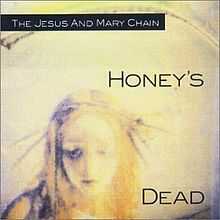Honey's Dead
| Honey's Dead | ||||
|---|---|---|---|---|
 | ||||
| Studio album by The Jesus and Mary Chain | ||||
| Released | 23 March 1992 | |||
| Recorded | 1991, The Drugstore | |||
| Genre | Alternative rock, noise rock | |||
| Length | 42:39 | |||
| Label | Blanco y Negro, Def American Recordings | |||
| Producer | William Reid, Jim Reid | |||
| The Jesus and Mary Chain chronology | ||||
| ||||
| Singles from Honey's Dead | ||||
|
||||
| Professional ratings | |
|---|---|
| Review scores | |
| Source | Rating |
| Allmusic | |
| Pitchfork Media | (6.9/10)[2] |
| Rolling Stone | |
| Piero Scaruffi | 6/10[4] |
Honey's Dead is the fourth studio album by the Scottish alternative rock band The Jesus and Mary Chain, released in 1992 on Blanco y Negro Records. The title refers to one of the band's early hits, "Just Like Honey", and is intended to demonstrate a complete departure from their earlier musical style.
The album's first single, "Reverence", attracted some controversy for the lyrics "I want to die just like Jesus Christ", and "I want to die just like JFK". Banned by Top of the Pops, the track peaked at #10 in the UK charts and received airplay in the United States on alternative radio stations.
Honey's Dead was recorded in the band's London studio, the aptly named "Drugstore", with accomplished engineer Flood and future JaMC producer Alan Moulder on board (not to mention a considerably larger bankroll).
Alternative and campus radio stations picked up "Far Gone and Out" which remains one of the band's most popular singles to date, peaking at #23 in the band's native UK. The Mary Chain shared the bill during parts of Lollapalooza 1992 in the U.S. with Pearl Jam, Soundgarden, Ministry, Lush, Ice Cube and the Red Hot Chili Peppers. Anheuser Busch even used the samples of "Sugar Ray" as a background bed for their Bud Ice television commercials in 1993.[5]
Honey's Dead was shortlisted for the 1992 Mercury Music Prize. The album posts a close second in sales to (1994) release Stoned & Dethroned (which contains the hit single "Sometimes Always" with Hope Sandoval of Mazzy Star). The Reid Brothers alternate between singing duties on tracks (most likely coinciding with songwriting duties).
Cover art
The album cover art features a detail from the painting Ophelia (First Version) by the Pre-Raphaelite painter Arthur Hughes.[6][7]
Track listing
All songs written by Jim Reid and William Reid.
- LP (BYN 26) and Cassette (BYNC 26)
Side 1
- "Reverence" – 3:40
- "Teenage Lust" – 3:06
- "Far Gone and Out" – 2:51
- "Almost Gold" – 3:19
- "Sugar Ray" – 4:41
- "Tumbledown" – 4:10
Side 2
- "Catchfire" – 4:47
- "Good for My Soul" – 3:05
- "Rollercoaster" – 3:46
- "I Can't Get Enough" – 2:56
- "Sundown" – 4:59
- "Frequency" – 1:19
- CD (BYNCD 26)
- "Reverence" – 3:40
- "Teenage Lust" – 3:06
- "Far Gone and Out" – 2:51
- "Almost Gold" – 3:19
- "Sugar Ray" – 4:41
- "Tumbledown" – 4:10
- "Catchfire" – 4:47
- "Good for My Soul" – 3:05
- "Rollercoaster" – 3:46
- "I Can't Get Enough" – 2:56
- "Sundown" – 4:59
- "Frequency" – 1:19
Notes
- Track 6: Contains a sample of Einstürzende Neubauten's "Tanz Debil" (Kollaps, 1981) starting at 1:25 and lasting for roughly 18 seconds.
- Track 9: Is listed as "copyright 1990" (while the rest of the album is "copyright 1992"), but the version here is not the original 1990 EP version. This version features live drums (presumably by Monti) and does not have the echo on William Reid's voice, and is likely a re-recorded version from the album sessions.
Personnel
The Jesus and Mary Chain
- Jim Reid - vocals (tracks 1, 2, 3, 5, 6, 8), guitar, producer
- William Reid - vocals (tracks 4, 7, 9, 10, 11, 12), guitar, producer
- Steve Monti - drums, percussion
Additional personnel
- Alan Moulder - engineer (except track 9), mixing
- Flood - engineer (track 9)
- Andy Catlin - photography
Notes
- ↑ http://www.allmusic.com/album/r55077
- ↑ http://www.pitchforkmedia.com/article/record_review/37601/The_Jesus_and_Mary_Chain_Psychocandy_Darklands_Automatic_Honeys_Dead
- ↑ RS 630
- ↑ Scaruffi, Piero (1999). "Jesus And Mary Chain". pieroscaruffi.com. Retrieved January 18, 2014.
- ↑ http://www.youtube.com/watch?v=07Qg6RKg0i4
- ↑ http://rateyourmusic.com/list/stephenscat/pre_raphaelite_paintings_used_in_front_covers/
- ↑ https://commons.wikimedia.org/wiki/File:Arthur_Hughes_-_Ophelia_(First_Version).JPG
| |||||||||||||||||||||||